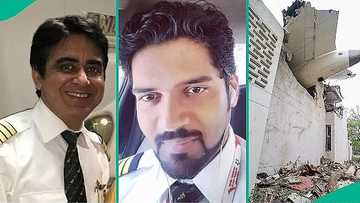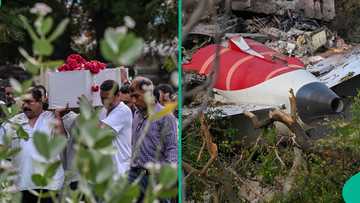Investigators Finally Release True Last Words of Air India Pilots to Each Other Before Plane Crash
- Investigators unveiled the final exchange between Air India Flight 171’s pilots seconds before the aircraft crashed, killing all on board but one
- The Boeing 787’s engines reportedly lost power after both fuel-control switches were shut off, a manoeuvre typically reserved for landing
- Aviation specialists said resolving the case hinged on matching pilot voices from the cockpit audio and understanding the moments before impact
Investigators have disclosed unsettling cockpit audio from Air India Flight 171, uncovering an eerie exchange moments before the jet crashed in India, killing all passengers except one on June 12, 2025.
As the aircraft lifted off from Ahmedabad, both fuel-control switches abruptly shifted to the 'cut-off' position, an action typically reserved for post-landing procedure, causing both engines to lose power.

Source: UGC
Seconds later, according to the recovered cockpit audio, one pilot was heard asking, 'Why did you cut off the switches?', to which the other pilot responded, 'I didn't'.

Read also
Investigators discover pilots allegedly shut off airplane engine by mistake in crash that killed 179
Air India crash investigation raises concerns
Officials said the Boeing 787 Dreamliner was airborne for less than a minute before plummeting into a densely populated neighbourhood.
The cockpit voice recording also indicated the co-pilot was flying at the time, while the captain was monitoring.
After the switches were returned to normal inflight settings, one engine began regaining thrust while the other was still recovering.
Despite clear skies, Flight 171 climbed to only 625 feet before location data was lost, according to FlightRadar24.
Investigators rule out accidental flipping of switches
Experts from Boeing, General Electric, India’s Directorate General of Civil Aviation, and teams from the UK and US are involved in the ongoing probe.
They reported that the lever-lock fuel switches required deliberate upward pulling before flipping, an intricate safeguard against accidental shutdown.
The system, first developed in the 1950s, is housed within protective guard brackets to prevent unintentional engagement.
“It would be almost impossible to pull both switches with a single movement of one hand, and this makes accidental deployment unlikely,” a Canada-based investigator told the BBC.

Read also
Air India Investigation: Captain Sumeet's instruction to co-pilot just before takeoff uncovered
Aviation experts question Air India pilot's intent
“Was it intentional, or the result of confusion? That seems unlikely, as the pilots reported nothing unusual,” said Shawn Pruchnicki, a former airline accident investigator at Ohio State University.
He added that cockpit confusion typically manifested through incorrect selections or emergency miscommunication, none of which were evident in this case.
Peter Goelz, a former managing director at the US National Transportation Safety Board (NTSB), described the findings as 'very disturbing'.
He said, “The new details suggest someone in the cockpit shut those valves. The question is, who, and why?”
Goelz further emphasised that the complete cockpit voice recording remains essential to determining the sequence of events.
He explained, “They haven’t identified the voices yet, which is crucial… As of now, we still don’t know which pilot turned the switches off and back on.”
Lack of cockpit video hinders investigation clarity
Investigators noted the lack of cockpit video as a limiting factor. A visual feed would have offered direct evidence of whose hand triggered the switches.

Read also
Air India: Man who lost 2 relatives in plane crash rejects investigation report, asks 2 questions
The NTSB has long recommended over-the-shoulder cockpit cameras, yet they remain absent in most commercial jets.
Both pilots passed breathalyser tests and were declared fit to fly before the incident, having arrived in Ahmedabad the day prior and receiving adequate rest.
Cockpit switches can misfire midair, says engineer
The Air India Express crash has triggered fresh scrutiny of cockpit safety systems, with an aerospace engineer warning about a rare but dangerous malfunction known as 'contact bounce.'
Speaking to Legit.ng, Dr Regnault Umaru Bamiji, an expert in aerospace systems and engineering innovation, said the crash showed the need to re-evaluate aircraft switch design under extreme conditions.
“The recent Air India Express crash has put a spotlight on a critical but often overlooked vulnerability: the reliability of cockpit interfaces and the potential for mechanical switches to misfire, even without human input.”
“Can vibration really cause switches to activate unintentionally? Yes, but it’s rare and shouldn’t occur in well-designed systems.”

Read also
Air India: Man who lost parents in plane crash questions government over investigation report
Dr Bamiji noted that modern aircraft are built to withstand vibration, but under unusual circumstances, faults could occur.
“Modern aircraft undergo rigorous testing to withstand vibration, yet under extreme conditions, worn or poorly shielded components can behave unpredictably,” he explained.
“This is known as ‘contact bounce’, where switches briefly open or close due to vibration, potentially sending incorrect signals to flight systems.”
2018 FAA advisory on fuel switch reliability resurfaces
The report also referenced a 2018 FAA Special Airworthiness Information Bulletin which flagged that locking features on some Boeing 737 fuel switches had been disengaged.
Although the finding did not warrant an Airworthiness Directive, it remains significant because the same design was used on the crashed Boeing 787-8, registration VT-ANB.
Air India reportedly did not act on the advisory.
Editorial assistant Ololade Olatimehin provided exclusive commentary from an aerospace engineer for this report.
Proofreading by Bruce Douglas, copy editor at Legit.ng.
Source: Legit.ng


